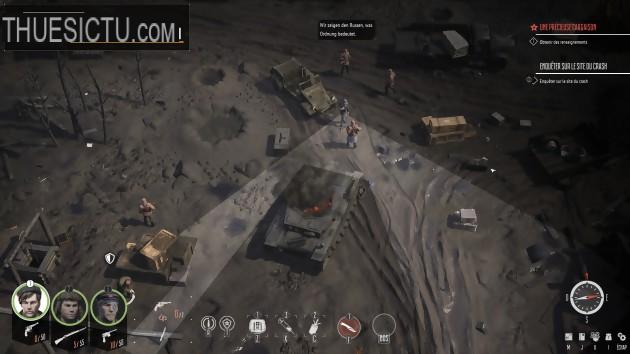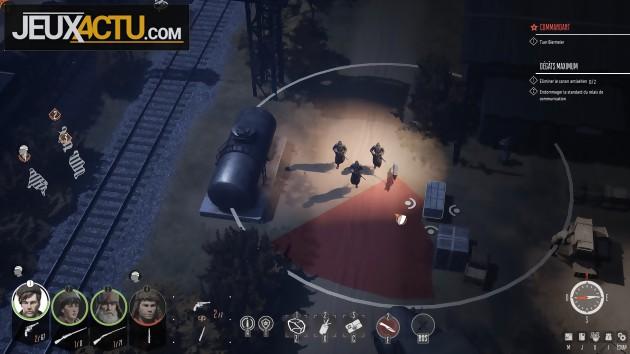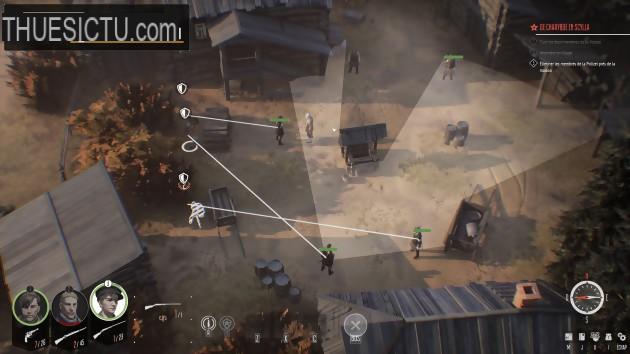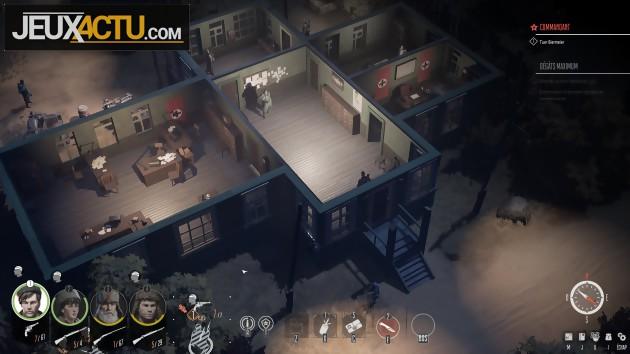
We are in June 1941, when the German army has just entered the soil of the Soviet Union and brought down several cities. Captain Zorin is taken prisoner and immediately sent to a Dulag. Trying everything for everything, the Russian officer managed to escape. And that's when the player takes control of the character. We then discover with pleasure that we are dealing with a faithful emulator of the Commandos and other Desperados, who does not forget any of the fundamentals of the genre. Thus, we find ourselves controlling several heroes simultaneously, the movements and the fights taking place in real time. But the emphasis is mainly on infiltration, and we spend most of our time trying to isolate this or that guard to create a breach in the opposing defenses. There are many tools for this, starting with the display of the cone of vision of enemies. It is possible to hide in bushes, cellars or cupboards, all these hiding places can also accommodate the corpses of our enemies, so that their colleagues do not fall on them and do not trigger the alert.
We will not hesitate either to throw stones to distract a guard, to drop a bottle on the ground to attract another, or to turn off lights so that an unwary person comes to check the circuit breaker. Environmental traps, on the other hand, serve to make our murders look like accidents. You are never safe from a badly wedged truck being repaired, a badly fixed military canteen, or a pile of unstable logs... But to get rid of a patrol it is also allowed to use the hard way. Either cowardly by laying a mine on the ground, or directly with grenades and shootings. For the latter, it is almost imperative to take cover, because without it our soldiers perish in a few seconds. Despite the presence of a tactical mode that slows down time and allows you to coordinate several actions, the general level of difficulty is very high. Moreover, the developers strongly recommend the easy mode for a first game. For our part, we played normally, and we can confirm that we suffered and multiplied the quick saves.
THE FAN CAMP
The game offers eight heroes in all, knowing that we generally control four at a time. Each of them has a skill tree that includes generic talents and one or two special talents. Thus, Zorin is adept at throwing a knife, Valya at chloroform, Trofim at shooting buckshot and Sanek at disguise. Morozov can whistle to lure out guards, Nikitin can nab one to use as a human shield, while Fetisov and Belozerova can take down several at once with a burst of submachine gun or pistol fire respectively. fan. Between two missions, the game offers us a small management phase in a headquarters. You can build a kitchen, a medical tent or even a workshop in this camp, just to make grenades, bandages or food. An injury system and morale management, with various penalties and bonuses, further enrich the experience. And to top it off, we can assign our heroes different tasks, which are all automatic quests whose outcome depends on a percentage of success. There are simple ones (sending a single character to harvest mushrooms guarantees a 100% result) and others riskier and more rewarding (only 75% chance of success with three heroes on the job, but experience gain and rare items if successful). Finally, this camp also serves the story thanks to some dialogues, non-interactive but which reinforce the atmosphere. Besides, the general atmosphere of the game is very pleasant. World War II is even more interesting on the Russian side, rarely dealt with in video games. And this context allows us to take ourselves for real resistance fighters since it leads us to destroy tanks, bridges and stations or even prevent the execution of partisans. Special mention for the prison mission and that of the Krasnoselskaya station, which offer large and well-made maps. The atmosphere is all the more successful as the guards speak German, including in the subtitles (and too bad for those who took Spanish as a second language in college).
50 SHADES OF GRAY AND BROWN
If the characters of the game are fictitious, we feel that the developers wanted to respect past events as much as possible, and their gravity. Unfortunately, this choice is also reflected in the artistic direction, which takes us through the entire palette of grays and browns. This turns out to be completely consistent with the representation that we have of these dark years, but the result still seems a little too dull to us. Especially since the relatively simple modeling of the characters does not really compensate for this. In addition, the game takes place almost entirely in autumn, which does not bring more variety in terms of colors. Only the very last mission takes place in the snow… but again the grayness prevails. Beyond these aesthetic considerations, it is above all the finish and the technical aspect that slightly darken the picture. Inventory management is far from optimal (after finishing the game, we're still trying to find out exactly how the tool to compare two weapons works…), while the pathfinding of heroes deserves to be reworked. We do not recommend that you trust them to get from point A to point B without supervision! They tend to pass through the guards' vision areas a bit too consistently. Even opening a simple door sometimes disturbs them, and you have to do it several times (our advice: do not click on the door, but directly on the floor of the room where you want to go). Finally, the game is subject to various and varied small bugs, ranging from the anecdotal (tutorial message that appears just before the end credits) to the annoying (alert triggered without any valid reason). And we even had several clear and clean crashes, with direct feedback under Windows. As you will have understood, Partisans 1941 is pleasant in substance, but imperfect from a technical point of view. Alter Games is a small studio made up of only twenty people, which may explain that. Fortunately, they seem to listen to players since a first patch has already emerged.


























